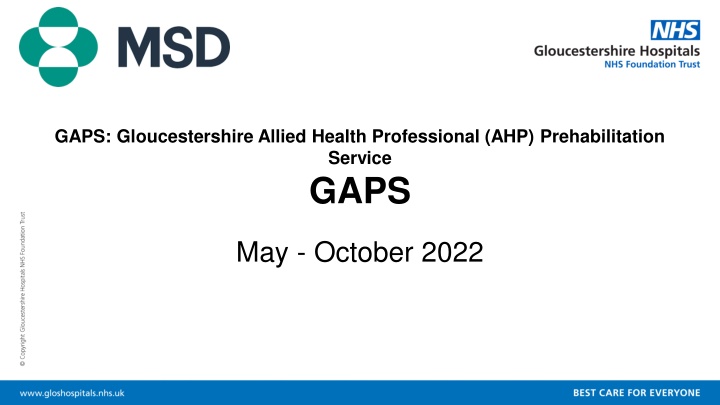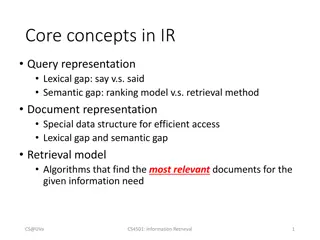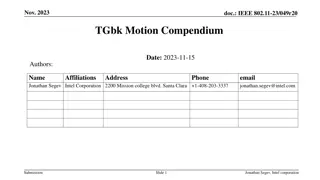
Gloucestershire Allied Health Professional prehabilitation service overview
"Learn about the GAPS service in Gloucestershire that offers prehabilitation through a team of allied health professionals, focusing on enhancing resilience and treatment management abilities for patients. The service includes a variety of interventions and screenings, catering to different patient needs and conditions."
Download Presentation

Please find below an Image/Link to download the presentation.
The content on the website is provided AS IS for your information and personal use only. It may not be sold, licensed, or shared on other websites without obtaining consent from the author. If you encounter any issues during the download, it is possible that the publisher has removed the file from their server.
You are allowed to download the files provided on this website for personal or commercial use, subject to the condition that they are used lawfully. All files are the property of their respective owners.
The content on the website is provided AS IS for your information and personal use only. It may not be sold, licensed, or shared on other websites without obtaining consent from the author.
E N D
Presentation Transcript
GAPS: Gloucestershire Allied Health Professional (AHP) Prehabilitation Service GAPS May - October 2022
The service The Team Physiotherapy Occupational therapy Psychology Dietitian Prescription of exercise, nutrition and psychological interventions. Proactive activities of daily life(ADL) management based on frailty status.
The Project Aims to increase resilience and ability to manage treatments with reduced effects.
The service Dietetic Scored Patient generated subjective global assessment (PG-SGA) Psychology PHQ-4 OT Rockwood clinical frailty Score Physio International Physical Activity Questionnaire (IPAQ) SCREENING INTERVENTIONS Universal Talk (one off) Why participate in prehab Myth busting Universal Weekly Group exercise classes Targeted First Line advice Nutrition, physical or psychological Specialist 1:1 interventions As screening identifies
Advice given 2% Virtual attendance 10% DNA 1% UTC 6% Unable to see prior to Tx 3% Patient Declined 13% Palliative 4% Face to Face attendance 49% Literature sent 12% Outcomes of Lung patients referred to Prehab Service
Performance Status: Treatment Collated at the request of Lung Clinical Team to help guide future management of patients with a performance status of 2
Impact of Prehab in maintaining and reducing Performance Status: All Lung Patients with input from Prehab Team
Impact of Prehab in maintaining and reducing Performance Status: Radiotherapy Breakdown
Impact of Prehab in maintaining and reducing Performance Status: Lung Patients seen in face-to-face Prehab Team sessions
Impact of Prehab in maintaining and reducing Performance Status: Lung Patients with input from Prehab Team: face-to-face/virtual/advice
Qualitative Survey Results Maintained behaviour change post intervention Service satisfaction
Patient Engagement Out of 190 referrals: 158 participated 32 declined/ incomplete Reasons for non-engagement Felt fit enough Felt too much going on Wanted to wait for results and then treatment started = 83% participation rate Reasons for incomplete Rapid deterioration Surveillance and not for treatment Non-cancerous Alternate primary OOA
Strategies to improve Lung Team Prehabilitation Team Reviewing pathway to offer more targeted and specialist support to non-engagers Improving links in community to refer to other services (ie Sue Ryder, Maggie s, Glos Can Exs) etc New psychology post Referral at point of first contact to optimise Prehab time Referral criteria- all patients Cc ing onto clinic letters working well Highlight importance of Prehab at consult Referral to Prehab Leaflet available to distribute to patients on intranet + internet
What we have learnt Patients are most likely to engage when advised to do so by the clinical team (Medics & nurses). Interventions are most effective and more likely to affect change in treatment with patients with a performance status of 2, but all PS patients benefit from general messaging, increasing physical activity and proactive management. Need Physio rather than a personal trainer to deliver exercise to this complex clinical group to prevent delays.
What we have learnt, continued Completing outcomes measures at the end of treatment is difficult and does not necessarily indicate positive change. All patients regardless of PS benefit from general messaging, increasing physical activity and proactive management. Need more emphasis on long term smoking cessation and continuing exercise. Need smooth transition to rehab services.
Prehab AHPs Physiotherapist Role Challenges Need for more targeted interventions (managing breathlessness, DBE s) Offer more than weekly exercise Psychologist Role Challenges AP role difficult in a new evolving service New post to be advertised for Psychologist Dietitian Role Challenges (patient s already been provided with nutrition advice prior to dietetic consult) OT Role Challenges Proactive frailty identification and palliation
Case Study Overview 79yr old female T3 M2 N0 PS =1 PG-SGA =8 IPAQ- no activity PHQ4= 0 Treatment Plan- Palliative chemotherapy
Prehab Intervention covering topics such as: Optimising nutrition prior to treatment, optimising physical activity, promoting oral hygiene, fatigue management strategies, and improving emotional resilience. Universal Session Tailored 1:1 Dietetics providing individualised support in order to optimise nutritional status and minimise further weight loss prior to treatment beginning High Percentage weight loss, at high risk of cachexia, poor appetite Specialist Dietitian Group exercise classes weekly Personalised home exercise programme Tailored goal setting support Specialist Physiotherapy
Prehabilitation Outcomes Initial Discharge Pre test RPE (Borg Scale) 1 1 Number of Repetitions 7 8 Post test RPE (Borg Scale) 7 2 Initial Weight Discharge Weight 72kg 72kg Conclusion: Utilising a person-centred approach, the Prehabilitation intervention supported Mrs P to optimise her pre-treatment baseline to reduce the severity and onset of treatment related side effects. Mrs P was able to tolerate all of her scheduled cycles of chemotherapy.






















